In most businesses, CX quality is a key differentiating factor among competitors. Deploying a VoC program is important for ensuring customer input is requested and valued.
However, implementing a voice of customer program can be challenging, as it requires businesses to collect feedback from a diverse range of customers and act on it in a timely manner.
Despite these challenges, the benefits of VoC programs are clear, as poor customer experiences result in significant losses for businesses each year. By implementing a voice of customer best practices, businesses can improve their customer experience and avoid these losses.
What is the Voice of the Customer (VoC)?
Voice of Customer (VoC) is defined as a customer-centric approach that captures and analyzes customer feedback to understand the customer experience. It helps companies gain insight into their customers’ opinions, and preferences to develop better products, services, and marketing strategies.
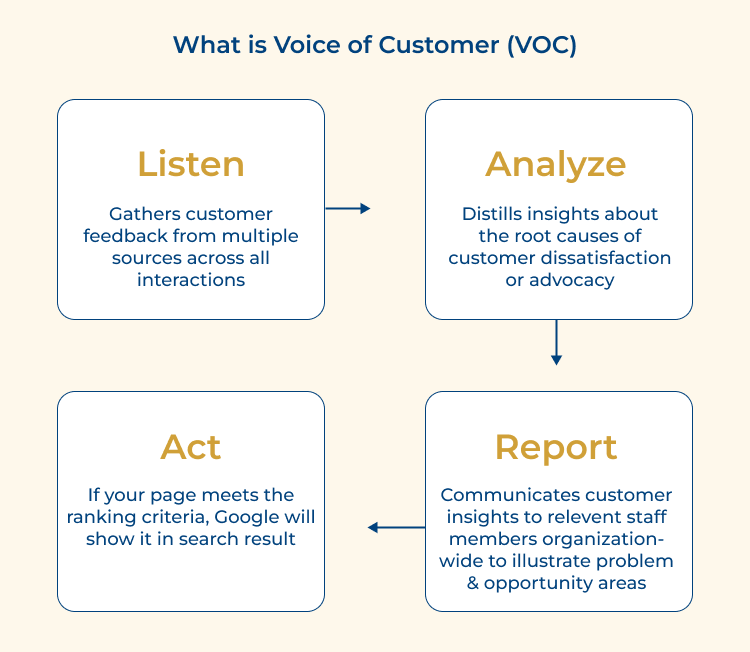
Voice of Customer tools and software allow companies to collect customer feedback from various sources such as surveys, interviews, product reviews, and social media. This data can be used to inform decisions about product design, marketing campaigns, customer service initiatives, and overall customer satisfaction.
Companies can also use VoC to identify customer pain points and develop solutions that address them. Additionally, Voice of Customer best practices help companies optimize the way they collect and analyze customer data to get more accurate insights.
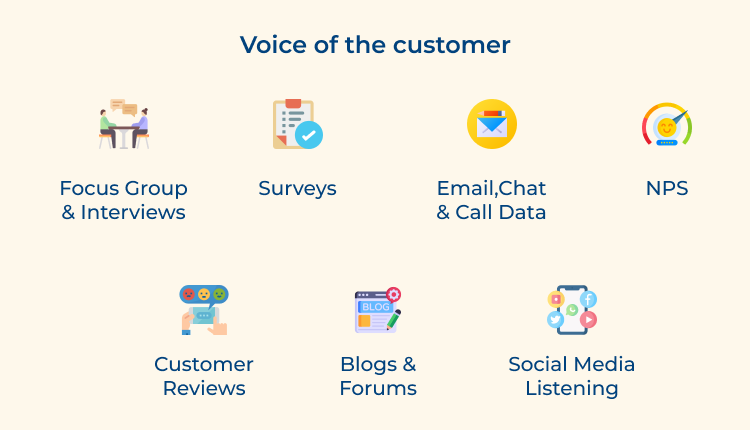
VOC data can be collected through various methods such as surveys, interviews, focus groups, or other methods.
Its key objectives include:
- Capture customer feedback across their journey to identify pain points.
- Get real time feedback about your product or service before it turns into a negative review.
- Measure customer experience over a period of time to understand customer satisfaction.
The Benefits Of Implementing a VoC Program
The importance of VOC lies in the fact that it allows organizations to gain valuable insights into their customers’ perspectives and experiences. This data can then be used to inform decisions about product development, marketing, and customer service.
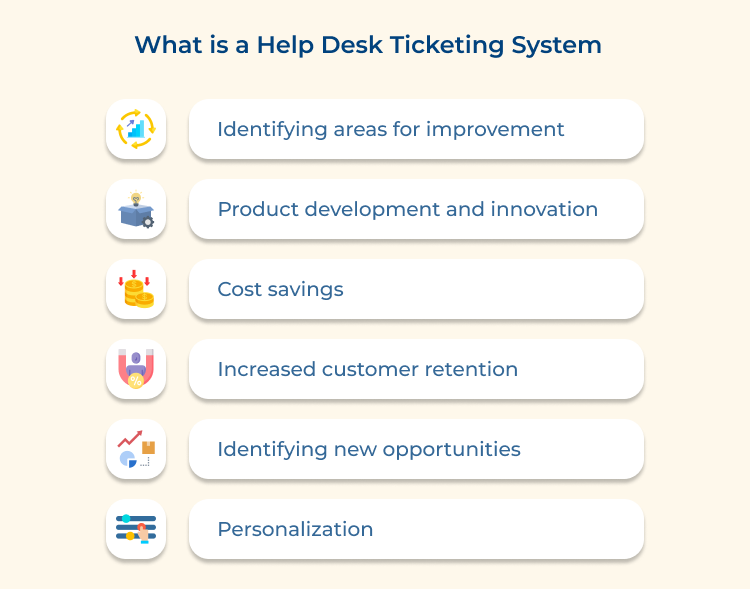
- Identifying areas for improvement: By gathering and analyzing customer feedback, Voice of the Customer (VOC) allows organizations to identify areas where they need to improve in order to better meet customer needs and preferences.
- Product development and innovation: VOC enables organizations to understand customer needs and preferences and create products and services that better meet those needs, leading to increased revenue and a competitive edge in the market.
- Cost savings: By addressing customer complaints and issues through VOC, organizations can improve internal processes and operations, leading to cost savings and increased efficiency.
- Increased customer retention: By listening to the voice of the customer, organizations can identify and address customer complaints and issues, which can ultimately lead to improved customer retention and reduced customer churn.
- Identifying new opportunities: VOC enables organizations to gain insights into customer needs and preferences that they may not have been aware of previously, which can be used to identify new opportunities for growth and expansion.
- Personalization: By analyzing VOC data, e-commerce, retail, and online businesses can gain insights into the preferences of different segments of their customer base, which can be used to create more personalized marketing campaigns and product recommendations, leading to increased customer engagement and sales.
How to Create an Effective Voice of the Customer Program
Getting started with a Voice of Customer (VoC) program is an important part of understanding your customers and providing them with a great experience. VoC programs enable organizations to capture, analyze, and act on customer feedback in order to improve the customer experience.
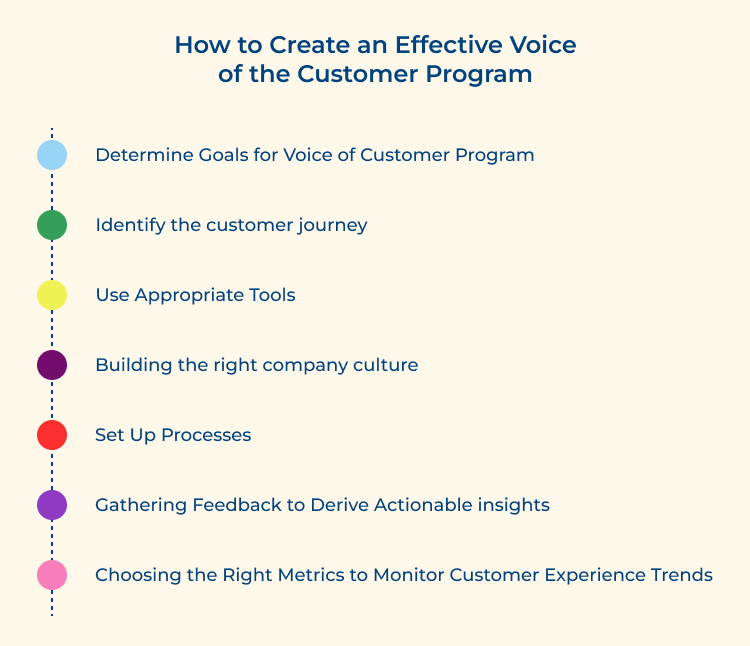
Here are seven steps you can take to get started with VoC.
1. Determine Goals for the Voice of Customer Program
Start by determining your goals for a VoC program. What do you hope to achieve? How do you want to use the data collected from the VoC program?
Knowing your goals will help you decide which metrics to track, how to analyze data, and how to use insights to improve the customer experience. Depending upon the nature of the business determining goals can act as a strategic roadmap and can be an effective operating tool.
Best practices:
- Determine what you want to improve to create a plan that solves actual pain points.
- Collect data from multiple sources. One is not enough.
- Use analytical VoC tools to inform decisions and quickly act upon insights.
- Aggregate your VoC data and integrate it with business systems.
2. Identify the Customer Journey
VoC programs start by identifying the various touchpoints that make up the customer experience with the company. and create a plan to capture feedback from those touchpoints.
Consider all stages of the customer journey, including pre-sale, purchase, delivery, usage, post-usage, and post-sale.
A customer journey map is a visual tool to help represent, analyze, and build shared understanding around a specific customer journey. As a tool of customer empathy, a good customer journey map will go beyond the customer’s mechanical actions into her thoughts and emotional experiences.
Best practices:
- Create customer journey maps as it allows them to step into the customer’s shoes, empathize, walk through a scenario, and identify ways to provide a better experience.
- VoC insights and customer journey maps are abstracted and built from current understanding. They often represent hypotheses and assumptions derived from limited sets of data.
3. Use Appropriate Tools
Once you have identified the touchpoints that need to be tracked, it’s time to decide what kind of VoC tools you should use.
In order to start the voice of the customer program, you need to look at the different sources and ways to collect customer feedback that’s applicable to your business.
There are many different options available, including online surveys, live chat, social media listening tools, customer feedback platforms, and more. Decide which tools will best meet your needs and budget.
Best practices:
- Survey questions should be short and simple and pushed out on the right channels at the right time to gather authentic customer feedback.
- Schedule interviews and calls with your customers periodically only to listen to them.
- Depending on the level of customer interaction involved in gathering the feedback, the VoC methodologies can be categorized as direct, indirect, or inferred.
4. Building the Right Company Culture
A fully functioning Voice of the Customer (VoC) program requires the right company culture, internal champions, and cross-functional collaboration. It means that the company culture should be customer-centric, with the C-suite leading efforts across all areas.
It ensures that everyone is aligned with the goal of improving the customer experience. The most effective VoC programs allow company leadership and staff to act upon the insights gleaned from customer feedback.
Best practices:
- You must have a clear plan in place for how to respond to customer feedback and ensure that everyone is aware of their role in addressing customer complaints and issues.
- Focus on valuing your staff because a dedicated team can go the extra mile to keep customers happy.
5. Set Up Processes
Set up processes for collecting and managing customer feedback, analyzing data, and responding to customer concerns. It may include setting up internal communication processes so that customer feedback is routed quickly to the right person or team within the organization.
When processes are streamlined the workflow is smooth delivering higher satisfaction and better experience to customers.
Best practices:
- Real-time listening across touchpoints.
- Data integration across touchpoints and enterprise systems.
- Efficient signal extraction from structured and unstructured data.
6. Gathering Feedback to Derive Actionable Insights
Choosing a lightweight survey format that is relevant to the customer interaction at hand is crucial to effectively gather customer feedback without creating friction or demanding effort from the customer.
Successful VoC programs go one step further than simply collecting feedback and customer experience metrics.
Best practices:
- Businesses can use this data to derive actionable insights that can be used to improve the customer experience.
- AI-powered text analytics software are a powerful tool that can be used to scan millions of open feedback entries in real-time and reveal recurring themes in areas for improvement.
7. Choosing the Right Metrics to Monitor Customer Experience Trends
Companies must consider which customer experience (CX) metrics are the best to track at each point in the customer journey.
Net Promoter Score (NPS), Customer Satisfaction (CSAT), and Customer Effort Score (CES) are some common metrics that can be used, depending on the context and what the company is trying to learn.
- Ongoing monitoring allows companies to track progress over time and make continuous improvements based on customer feedback.
- Businesses can learn the gaps continuously improve the customer experience and make necessary changes to the customer journey.
How to Measure the Voice of the Customer (VoC)? Metrics & Examples
VoC is a critical part of understanding your customers’ journey. VoC metrics consist of initiatives designed to capture customer insights, close the loop on feedback, and prioritize improvements to produce happy and successful clients.
Here are the VoC metrics that you should focus on, and some you may have been ignoring.
Net Promoter Score (NPS)
The NPS tells you if a customer would recommend your product, service, or business to others. It’s the difference between someone who interacted with your business and called it a day, or if they would actively promote your business to their friends, family, or colleagues.

Essentially, an NPS question is like: “Based on your experience with us, how likely are you to recommend us to a friend or colleague, on a scale of 0 to 6?”
Customer Satisfaction Score (CSAT)
The CSAT also referred to as OCS (Overall Customer Satisfaction) metric is, much like the name implies, a way to tell if the customer is satisfied with the overall experience of interacting with your business.

Typically used in transactional surveys, it provides a business with a general guideline as to whether or not the customer experience was positive.
The CSAT question is typically phrased like this: “On a scale of 1-5, how satisfied were you with your experience?”
Customer Satisfaction Score (CES)
The CES metric defines the effort that a customer has to exert in order to do business with you, reasoning that the less effort that is exerted, the better the experience for the customer.
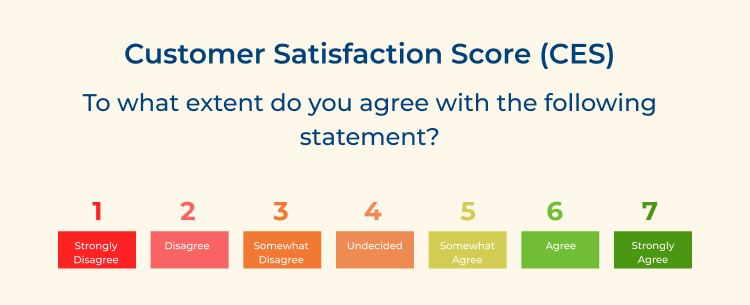
Usually, a CES question is very important. Typically it is phrased like this:
“To what extent do you agree with the following: [Company name] made it easy for me to purchase [what I wanted].”
Best Practices to Follow for Voice of Customer
It is critical to execute a successful Voice of Customer (VoC) program to stay competitive and maintain customer loyalty. As such, there are certain best practices that should be followed in order to maximize the effectiveness of your VoC program.
Here are some key best practices when it comes to implementing an effective VoC program:
- Understand the different types of customers you have and tailor your VoC efforts to gather feedback from each group.
- Use a variety of methods to gather feedback, such as surveys, focus groups, and customer interviews, to ensure you are capturing a diverse range of perspectives.
- Encourage customers to provide detailed feedback by using open-ended questions rather than multiple-choice or rating scale questions.
- Use technology such as AI-powered text analytics to quickly identify patterns and trends in feedback, allowing you to act on this information in a timely manner.
- Ensure that feedback is acted upon by assigning ownership and creating action plans to address customer concerns.
- Share customer feedback with the entire organization to ensure everyone is aware of customer needs and can take action to improve the customer experience.
- Regularly review feedback and track progress over time to ensure that efforts to improve the customer experience are having a positive impact.
- Encourage all employees to think about the customer experience and make it a core part of the company culture.
- Make it easy for customers to provide feedback and make it clear that their opinions are valued.
- Use key performance indicators (KPIs) to track progress and measure the effectiveness of your VoC efforts over time.
Key Questions to Answer Before Building Your Voice of Customer Strategy
Having a well-thought-out strategy for your Voice of Customer (VoC) program is key to creating an effective and successful customer experience. Knowing which questions to answer before beginning will help you create a strategy that meets your customers’ needs and gets the most out of the voice of the customer tools and software you use.
Here are five essential questions to consider when creating your VoC strategy:
Q.1. What are your customer experience goals?
Knowing what you’re trying to achieve with your VoC program will help you determine which metrics you should track, which voice of customer techniques to use, and how to best focus your efforts.
Q.2. What methods will you use to collect feedback?
It is important to understand what types of feedback you want to collect, how often you want to collect it, and which voice of customer tools or software you’ll use. This will ensure you get the data you need to make informed decisions.
Q.3. Who will analyze the data?
Understanding who will be responsible for analyzing the data collected is key to maximizing the value of the feedback. You’ll also want to determine if any additional training is needed in order for them to better understand and interpret the data.
Q.4. How will you act on customer feedback?
Once you have the data, it’s essential to have a plan for what action steps you’ll take as a result. Create a process for analyzing feedback, identifying patterns, and creating a plan for improvement based on what customers are saying.
Q.5. How will you measure success?
Defining metrics and setting goals will help ensure you can track progress and measure the success of your VoC program. Establishing these metrics before you begin will help ensure you get the most out of your efforts.
Voice of Customer Examples
By using voice-of-customer examples such as these, companies can gain insight into their customers’ needs and wants and use this data to create better products, services, and marketing campaigns.
Through surveys, polls, and engaging customers on social media, companies can start to develop an understanding of what their customers want from them. By collecting this data, companies can use it to improve the customer experience and create better products and services that meet their customers’ needs.
Apple
Apple has long been a leader in VoC, using customer feedback to shape product design and marketing campaigns. They have created surveys for customers to fill out after using their products, as well as engaging customers on social media with questions and polls. By understanding what their customers want, they have been able to create better products and services.
Dropbox
Dropbox relies heavily on customer feedback to improve their software. Through surveys, they are able to understand how customers use their product and how to make it better. Dropbox also uses social media to engage with customers, asking them questions about how they use their product and how it can be improved.
Microsoft
Microsoft has long been focused on gathering customer feedback. Through their customer feedback program, they regularly survey customers on their experiences with their products. They use this data to improve the customer experience, as well as shape product designs and marketing campaigns.
Amazon
Amazon is a leader in collecting customer feedback. They have a comprehensive feedback system that allows customers to easily provide feedback on the products they purchase. They also use social media to engage with customers, asking for feedback and advice on how to improve their services.
Implement Voice of Customer Program to Fuel Your Business Growth
Implementing a Voice of the Customer (VoC) program can be a powerful tool for driving business growth. By gathering and analyzing customer feedback, businesses can gain a deeper understanding of customer needs and desires, which can inform product and service improvements and help to create a more positive customer experience.
VoC data can also be used to inform pricing and marketing strategies and to identify new business opportunities. This, in turn, can lead to increased customer loyalty and repeat business, as well as positive word-of-mouth recommendations, which can help to drive new business.











